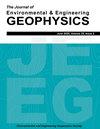探地雷达探测隧道衬砌内、后空洞的实验研究
IF 0.7
4区 工程技术
Q4 ENGINEERING, GEOLOGICAL
引用次数: 10
摘要
探地雷达被认为是探测隧道衬砌空洞的有效工具。本文采用物理隧道衬砌模型进行了实验研究,以评估不同天线频率下的性能。建立了长4.2 m、宽4.2 m、高2.0 m的隧道结构二次衬砌、初始衬砌和围岩实验模型。在模型中,我们创建了四种类型的空洞,分别是二次衬砌和初始衬砌中的空洞,二次衬砌和初始衬砌之间的分层,初始衬砌与砂土之间的分层,以及埋在砂土中的空洞,以模拟隧道工程中的实际情况。采用反射法测量模型中砂土和混凝土中的探地雷达波速,标定空洞深度。我们使用了一套商用探地雷达系统,配备了不同中心频率的天线来探测空洞。采用常规的数据处理流程对探地雷达数据进行处理,考察了不同频率下的性能。结果表明,1000 MHz中心频率探地雷达能够探测到二次衬砌中的浅埋空洞,但不能穿透到初始衬砌中。250兆赫中心频率GPR系统不建议探测隧道衬砌内部或背后的空洞,因为它对厘米大小的空洞的分辨率很低。500 MHz中心频率探地雷达系统是最适合空洞探测的系统,因为它展示了平衡的分辨能力和探测深度。研究结果可为实际探地雷达应用中的天线选择和数据处理提供参考。本文章由计算机程序翻译,如有差异,请以英文原文为准。
Experimental Study on GPR Detection of Voids inside and behind Tunnel Linings
Ground penetrating radar (GPR) is considered an effective tool to detect tunnel lining voids. In this paper, an experimental study was carried out using a physical tunnel lining model to evaluate the performances of different antenna frequencies. We built a 4.2 m–long, 4.2 m–wide, and 2.0 m–high experimental model to simulate the secondary lining, initial lining, and surrounding rock of a tunnel structure. In the model, we created four categories of voids, which are voids in secondary and initial linings, a delamination between the secondary and initial linings, a delamination between the initial lining and sand, and a void buried in the sand, to simulate real cases in tunnel engineering. The GPR wave velocities in the sand and concrete of the model were measured using the reflection method for the calibration of void depth. We employed a commercial GPR system equipped with antennae of different centre frequencies to detect the voids. GPR data were processed using a conventional data processing flow, and the performances of different frequencies were examined. The results show that the 1000 MHz centre frequency GPR is capable of characterizing shallow buried voids in the secondary lining but is not able to penetrate into the initial lining. The 250 MHz centre frequency GPR system is not advised to detect voids in or behind tunnel linings due to its low resolving power for voids of centimetre sizes. The 500 MHz centre frequency GPR system is optimal for void detection because it demonstrated a balanced performance of resolving ability and investigation depth. The findings of this work could be useful references for antenna selection and data processing in real GPR applications.
求助全文
通过发布文献求助,成功后即可免费获取论文全文。
去求助
来源期刊

Journal of Environmental and Engineering Geophysics
地学-地球化学与地球物理
CiteScore
2.70
自引率
0.00%
发文量
13
审稿时长
6 months
期刊介绍:
The JEEG (ISSN 1083-1363) is the peer-reviewed journal of the Environmental and Engineering Geophysical Society (EEGS). JEEG welcomes manuscripts on new developments in near-surface geophysics applied to environmental, engineering, and mining issues, as well as novel near-surface geophysics case histories and descriptions of new hardware aimed at the near-surface geophysics community.
 求助内容:
求助内容: 应助结果提醒方式:
应助结果提醒方式:


